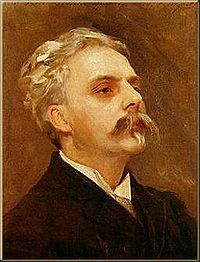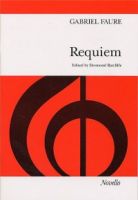Faure Requiem Vocal Score
 Vocal Scores for Faure's Requiem
Vocal Scores for Faure's Requiem
Requiem is probably the most famous of Gabriel Faure 's long works and has become a firm favourite in the repertoire.
The most popular vocal score for Bach's Christmas Oratorio is shown below.
Rehearsal recordings to help learn your voice part (Soprano, Alto, Tenor, Bass) are described below.
Full video version to hear the work in full is also below
The Novello edition is in Latin and is edited by Desmond Ratcliff for SATB.

Catalogue NumberNOV072304
ISBN:9780853604082
Please click here if you wish to order and further vocal score information
Please order by 3pm to be despatched today




Fauré's reasons for composing his Requiem are uncertain. One possible impetus may have been the death of his father in 1885, and his mother's death two years later on New Year's Eve 1887. However, by the time of his mother's death he had already begun the work, which he later declared was "composed for nothing … for fun, if I may be permitted to say so!"
The earliest composed music included in the Requiem is the "Libera Me", which Fauré wrote in 1877 as an independent work.
In 1887–88, Fauré composed the first version of the work, which he called "un petit Requiem" with five movements (Introit and Kyrie, Sanctus, Pie Jesu, Agnus Dei and In Paradisum), but did not include the "Libera Me". This version was first performed January 16, 1888 under the composer’s direction in La Madeleine in Paris. The treble soloist was Louis Aubert, and the occasion was the funeral of one Joseph La Soufaché, an architect.
In 1889, Fauré added the "Hostias" portion of the Offertory and in 1890 he expanded the Offertory and added the 1877 "Libera Me". This second version, known today as the chamber orchestra version, was premièred January 21, 1893, again at the Madeleine with Fauré conducting.
In 1899–1900, the score was reworked for full orchestra. There is some question as to whether this was the work of Fauré himself or one of his students (see below). This version was premiered April 6, 1900, with Eugène Ysaÿe conducting. It was the best known version until John Rutter rediscovered Fauré's original manuscript of the chamber orchestra version in the Bibliothèque Nationale in Paris in the early 1980s.
In 1924 the Requiem was performed at Fauré's own funeral. It was not performed in the United States until 1931, and then only at a student concert at the Curtis Institute in Philadelphia. It did not reach England until 1936. I
The piece has a duration of about 35 minutes. It consists of seven movements:
* I. Introït et Kyrie (D minor)
* II. Offertoire (B minor)
* III. Sanctus (E flat major)
* IV. Pie Jesu (B flat major)
* V. Agnus Dei et Lux Aeterna (F major)
* VI. Libera me (D minor)
* VII. In Paradisum (D major)
All the text is in Latin (except for the Kyrie, which is Koine Greek). As had become normal, Fauré did not set the Gradual and Tract sections of the Mass, but he further departed from convention by not setting the Requiem Sequence (the Dies irae poem, which contains other well-known sections such as the Rex tremendae and Lacrimosa). He slightly altered the texts of the Introit, the Kyrie, Pie Jesu, the Agnus Dei, and In Paradisum, but changed substantially the text of the Offertory (described below). He did not set the Benedictus (an optional, but conventional, adjunct to the Sanctus), and added the motet Pie Jesu (the final part of the Dies irae text) and two texts from the Order of Burial, Libera me and In Paradisum.
Fauré's alterations to the text of the Offertory are as follows. He adds "O" at the beginning. He changes "libera animas omnium fidelium defunctorum" ("deliver the souls of all the faithful departed") to simply "libera animas defunctorum" ("deliver the souls of the departed"), which, it can be argued, is a fundamental theological change. He replaces "Libera eas" ("Deliver them") at the beginning of the next verse with a repetition of "O Domine Jesu Christe, Rex gloriae, libera animas defunctorum", and he omits the third verse (beginning "Sed signifer sanctus..."). He adds "Amen" at the end.




ChoraLine 'Voice Part' Rehearsal CDs & EasyPlay (Stream & Download)
Quick and Easy way to memorise your vocal line and practise between choir rehearsals

Know Your Notes Perfectly
Enhance Your Enjoyment when Singing
Learn With The Music
Shine In Your Choir
Sing With Confidence
Please click here to hear a ChoraLine sample for Faure's Requiem




If you wish to have a CD of Requiem to hear the whole work please click here and please do click on the video below to listen right away if you wish




